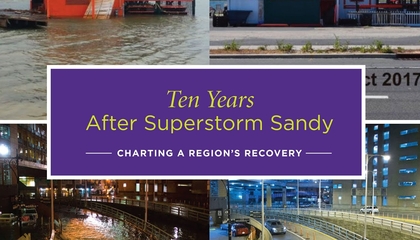
Devastation, Recovery, and Resilience in New York and New Jersey
A decade after Hurricane Sandy, a new report by researchers at the NYU School of Global Public Health’s Center for Public Health Disaster Science describes the long-term impact of the storm on 18 counties in New York and New Jersey.
The analysis reveals a story of short-term destruction and hardship, followed by robust recovery and resilience on other measures, suggesting that the lasting impact of Superstorm Sandy on the region and its population was muted.
The immediate aftermath of Hurricane Sandy was dramatic: the storm damaged or destroyed 650,000 homes, took more than 150 lives, and generated nearly $82 billion in damage. The new report, Ten Years After Sandy: Charting a Region’s Recovery, looked at the extent to which systems in the country’s largest metropolitan area were disrupted with enduring consequences over the next decade.
Read the Full Report
The New York and New Jersey areas most affected by Hurricane Sandy were remarkably resilient, likely due to their considerable resources, effective governments, and strong critical infrastructure. We found that even a massive storm such as Sandy did not fundamentally disrupt the systems for more than a year.
Using publicly available data, the researchers examined critical dimensions of disaster recovery, such as population health, the regional economy, housing, education, and civic and social engagement. They included 20 years of data—a decade before and after Superstorm Sandy—to explore long-term trends.
The analysis focused on 18 counties in New Jersey and New York as the areas most affected by Superstorm Sandy: Atlantic, Bergen, Cape May, Essex, Hudson, Middlesex, Monmouth, Ocean, and Union in New Jersey; and Bronx, Kings (Brooklyn), New York (Manhattan), Nassau, Queens, Richmond (Staten Island), Suffolk, Westchester, and Rockland in New York.
Key Findings:
- New York City—particularly Manhattan—provided substantial financial stability to the region, thanks to highly skilled industries (e.g. Wall Street, media) scaling back up quickly after the disaster. The hurricane had only a small and short-lived effect on employment trends in the affected counties. The 2008-2009 recession and COVID-19 pandemic had much more pronounced economic impacts than the storm.
- The hurricane did not have a measurable effect on measures of social and civic engagement, including crime and voting.
- Hurricane Sandy had a mixed effect on the region’s housing. Most homeowners were unprepared and underinsured for the flooding that occurred; foreclosures increased in the year after the storm. However, in the decade that followed, home values in the coastal and urban areas affected by Sandy have actually increased by 50%, a greater rate than in the counties less affected by the storm.
- The storm did not influence measures of health, including preventable hospitalizations for conditions such as asthma and pneumonia, nor deaths attributable to drugs, alcohol use, and suicide.
Additional Research:
- David Abramson, Donna Van Alst, Alexis Merdjanoff, Rachael Piltch-Loeb, Jaishree Beedasy, Patricia Findley, Lori Peek, Meghan Mordy, Sandra Moroso, Kerrie Ocasio, Yoon Soo Park, Jonathan Sury and Jennifer Tobin-Gurley (2015). The Hurricane Sandy Place Report: Evacuation Decisions, Housing Issues and Sense of Community. The Sandy Child and Family Health Study. Rutgers University School of Social Work, New York University College of Global Public Health, Columbia University National Center for Disaster Preparedness, Colorado State University Center for Disaster and Risk Analysis, Briefing Report 2015_1.
- David Abramson, Donna Van Alst, Alexis Merdjanoff, Rachael Piltch-Loeb, Jaishree Beedasy, Patricia Findley, Lori Peek, Meghan Mordy, Sandra Moroso, Kerrie Ocasio, Yoon Soo Park, Jonathan Sury and Jennifer Tobin-Gurley (2015). The Hurricane Sandy Person Report: Disaster Exposure, Health Impacts, Economic Burden, and Social Well-Being. Sandy Child and Family Health Study, Rutgers University School of Social Work, New York University College of Global Public Health, Columbia University National Center for Disaster Preparedness, Colorado State University Center for Disaster and Risk Analysis , Briefing Report 2015_2.
- David M. Abramson and Irwin Redlener (2012). Hurricane Sandy: Lessons Learned, Again. Disaster Med Public Health Preparedness. 6:328-329.
- Thomas Chandler, David Abramson, Benita Panigrahi, Jeff Schlegelmilch and Noelle Frye (2016). Crisis Decision-Making During Hurricane Sandy: An Analysis of Established and Emergent Disaster Response Behaviors in the New York Metro Area. Disaster Med Public Health Preparedness. 10:436-442.
- Alexis Merdjanoff, David M. Abramson, Rachael Piltch-Loeb, Patricia Findley, Lori Peek, Jaishree Beedasy, Yoon Soo Park, Jonathan Sury and Gabriella Meltzer (2021). Examining the Dose–Response Relationship: Applying the Disaster Exposure Matrix to Understand the Mental Health Impacts of Hurricane Sandy. Clinical Social Work Journal.
- Alexis Merdjanoff, Rachael Piltch-Loeb, Sarah Friedman and David Abramson (2018) Housing Transitions and Recovery of Older Adults Following Hurricane Sandy. J Gerontol B Psychol Sci Soc Sci, Vol. 74, No. 6, 1041–1052
Social Structures
"This work emphasizes the importance of social structures in people’s lives, particularly after a disaster. That structure includes strong economic and housing markets, as well as effective government response. We have seen in our work with the Katrina and Sandy cohorts how variable that is, but overall the New York-Jersey area displayed a robust recovery.”
~Alexis Merdjanoff, clinical assistant professor of social and behavioral sciences and coauthor author of the new report
